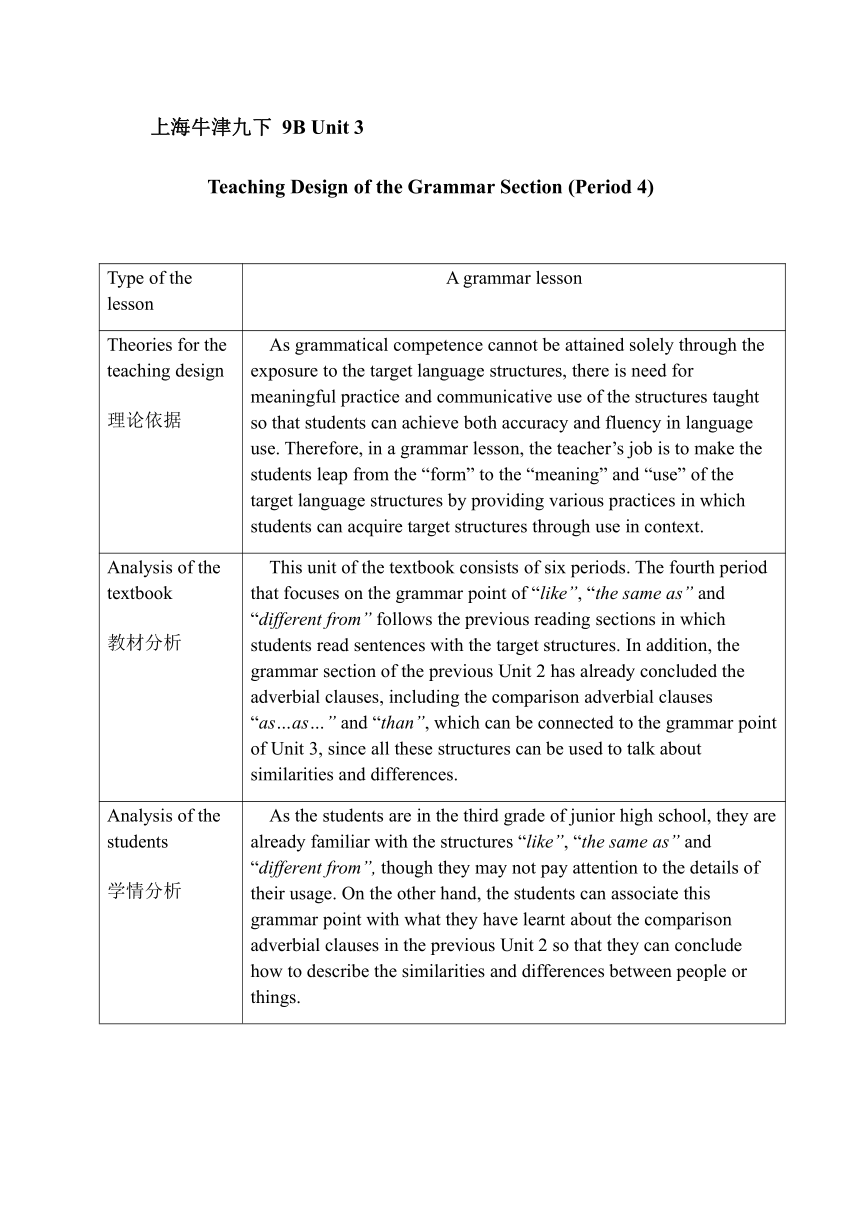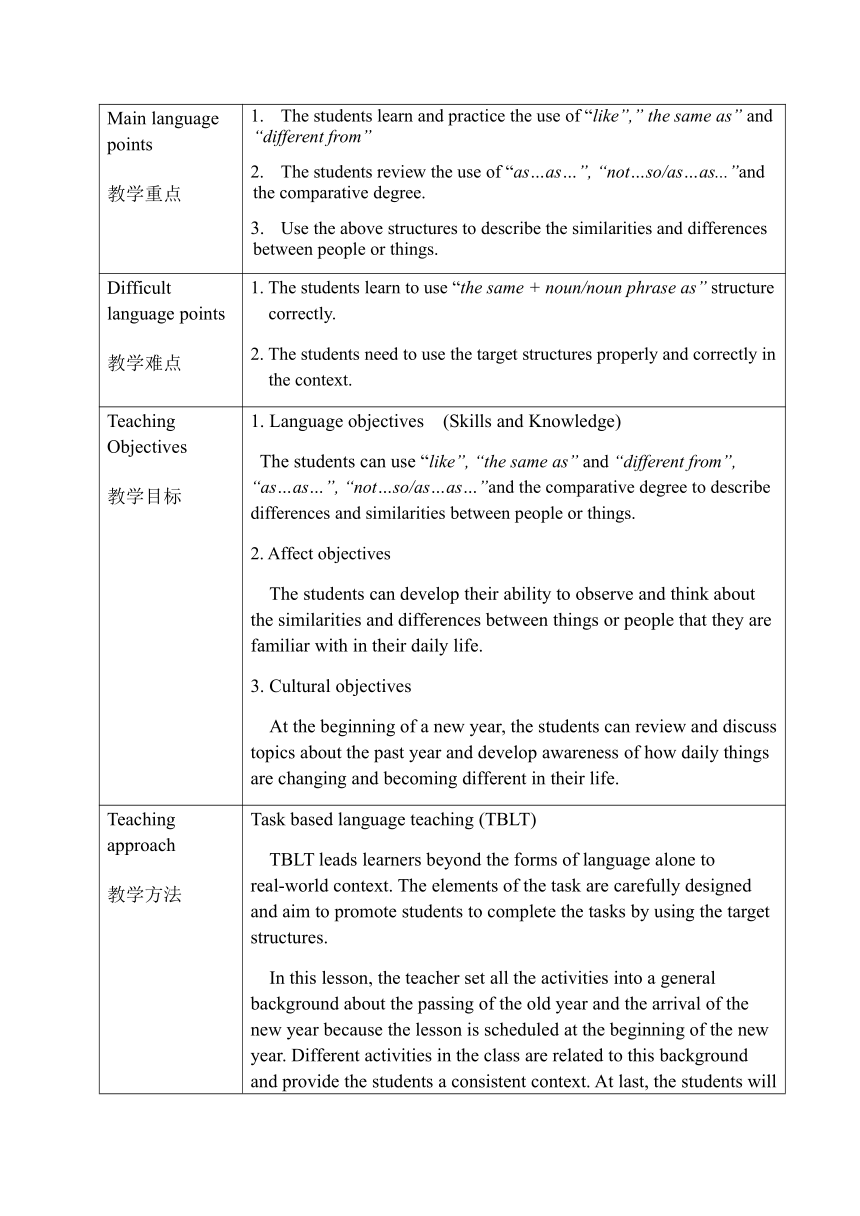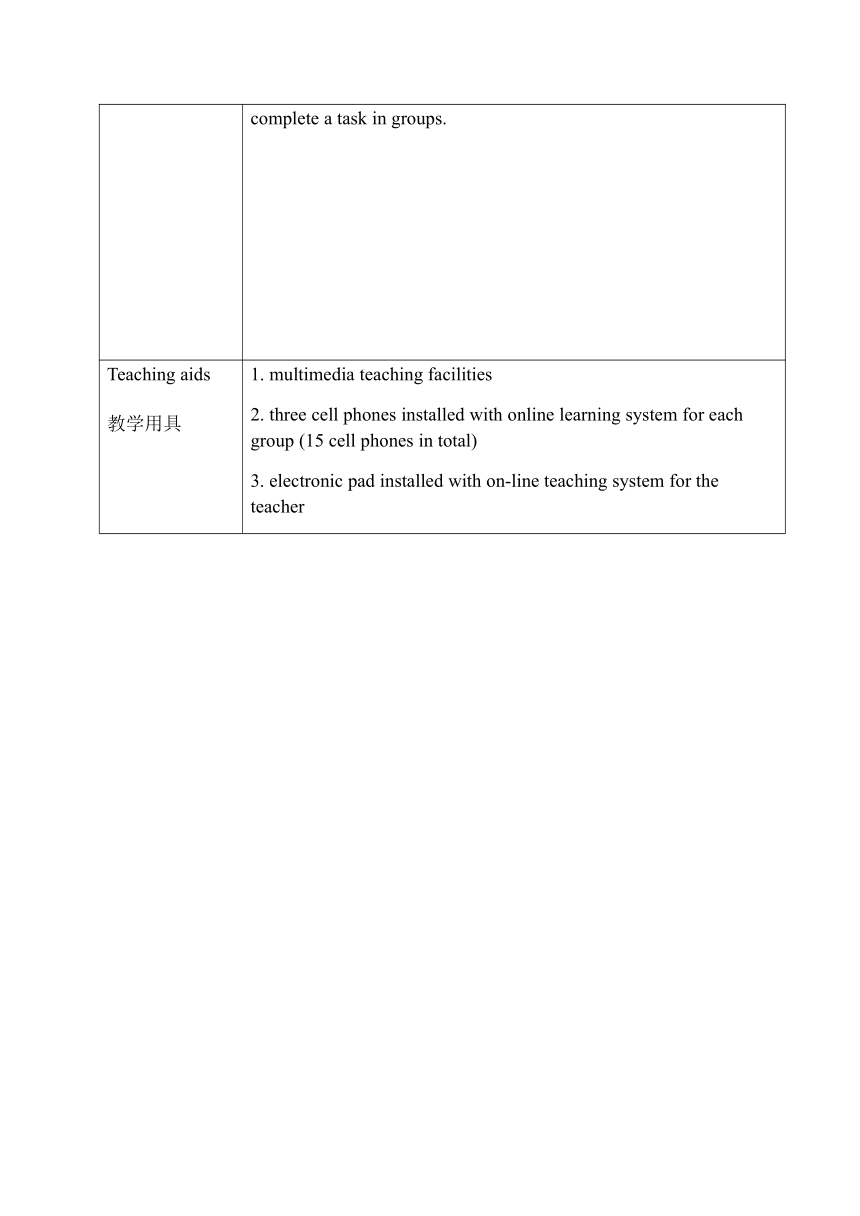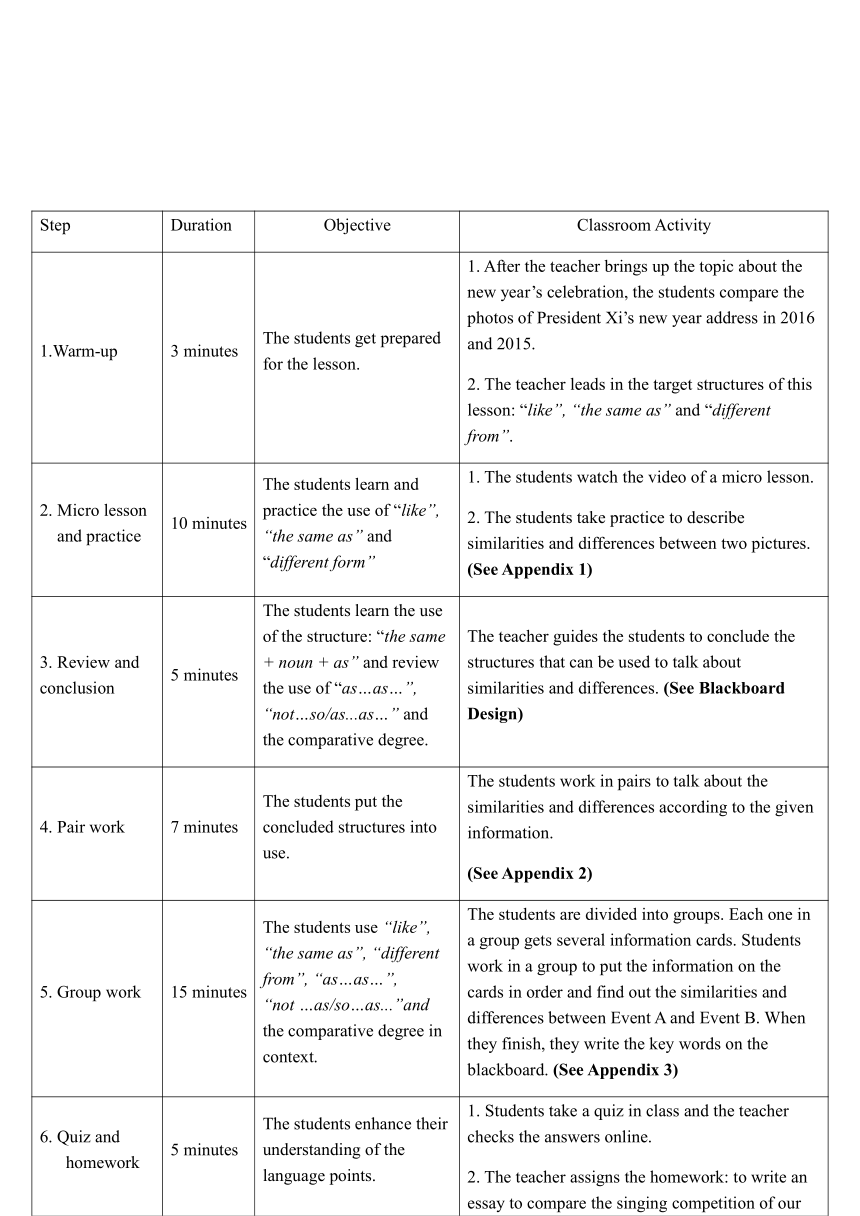牛津上海版英语九年级下册Unit 3 going places (Period 4) Grammar 教案(表格式)
文档属性
| 名称 | 牛津上海版英语九年级下册Unit 3 going places (Period 4) Grammar 教案(表格式) |  | |
| 格式 | docx | ||
| 文件大小 | 1.7MB | ||
| 资源类型 | 教案 | ||
| 版本资源 | 牛津上海版(试用本) | ||
| 科目 | 英语 | ||
| 更新时间 | 2022-06-08 15:39:01 | ||
图片预览





文档简介
上海牛津九下 9B Unit 3
Teaching Design of the Grammar Section (Period 4)
Type of the lesson A grammar lesson
Theories for the teaching design 理论依据 As grammatical competence cannot be attained solely through the exposure to the target language structures, there is need for meaningful practice and communicative use of the structures taught so that students can achieve both accuracy and fluency in language use. Therefore, in a grammar lesson, the teacher’s job is to make the students leap from the “form” to the “meaning” and “use” of the target language structures by providing various practices in which students can acquire target structures through use in context.
Analysis of the textbook 教材分析 This unit of the textbook consists of six periods. The fourth period that focuses on the grammar point of “like”, “the same as” and “different from” follows the previous reading sections in which students read sentences with the target structures. In addition, the grammar section of the previous Unit 2 has already concluded the adverbial clauses, including the comparison adverbial clauses “as…as…” and “than”, which can be connected to the grammar point of Unit 3, since all these structures can be used to talk about similarities and differences.
Analysis of the students 学情分析 As the students are in the third grade of junior high school, they are already familiar with the structures “like”, “the same as” and “different from”, though they may not pay attention to the details of their usage. On the other hand, the students can associate this grammar point with what they have learnt about the comparison adverbial clauses in the previous Unit 2 so that they can conclude how to describe the similarities and differences between people or things.
Main language points 教学重点 The students learn and practice the use of “like”,” the same as” and “different from” The students review the use of “as…as…”, “not…so/as…as...”and the comparative degree. Use the above structures to describe the similarities and differences between people or things.
Difficult language points 教学难点 1. The students learn to use “the same + noun/noun phrase as” structure correctly. 2. The students need to use the target structures properly and correctly in the context.
Teaching Objectives 教学目标 1. Language objectives (Skills and Knowledge) The students can use “like”, “the same as” and “different from”, “as…as…”, “not…so/as…as…”and the comparative degree to describe differences and similarities between people or things. 2. Affect objectives The students can develop their ability to observe and think about the similarities and differences between things or people that they are familiar with in their daily life. 3. Cultural objectives At the beginning of a new year, the students can review and discuss topics about the past year and develop awareness of how daily things are changing and becoming different in their life.
Teaching approach 教学方法 Task based language teaching (TBLT) TBLT leads learners beyond the forms of language alone to real-world context. The elements of the task are carefully designed and aim to promote students to complete the tasks by using the target structures. In this lesson, the teacher set all the activities into a general background about the passing of the old year and the arrival of the new year because the lesson is scheduled at the beginning of the new year. Different activities in the class are related to this background and provide the students a consistent context. At last, the students will complete a task in groups.
Teaching aids 教学用具 1. multimedia teaching facilities 2. three cell phones installed with online learning system for each group (15 cell phones in total) 3. electronic pad installed with on-line teaching system for the teacher
Step Duration Objective Classroom Activity
1.Warm-up 3 minutes The students get prepared for the lesson. 1. After the teacher brings up the topic about the new year’s celebration, the students compare the photos of President Xi’s new year address in 2016 and 2015. 2. The teacher leads in the target structures of this lesson: “like”, “the same as” and “different from”.
2. Micro lesson and practice 10 minutes The students learn and practice the use of “like”, “the same as” and “different form” 1. The students watch the video of a micro lesson. 2. The students take practice to describe similarities and differences between two pictures. (See Appendix 1)
3. Review and conclusion 5 minutes The students learn the use of the structure: “the same + noun + as” and review the use of “as…as…”, “not…so/as...as…” and the comparative degree. The teacher guides the students to conclude the structures that can be used to talk about similarities and differences. (See Blackboard Design)
4. Pair work 7 minutes The students put the concluded structures into use. The students work in pairs to talk about the similarities and differences according to the given information. (See Appendix 2)
5. Group work 15 minutes The students use “like”, “the same as”, “different from”, “as…as…”, “not …as/so…as...”and the comparative degree in context. The students are divided into groups. Each one in a group gets several information cards. Students work in a group to put the information on the cards in order and find out the similarities and differences between Event A and Event B. When they finish, they write the key words on the blackboard. (See Appendix 3)
6. Quiz and homework 5 minutes The students enhance their understanding of the language points. 1. Students take a quiz in class and the teacher checks the answers online. 2. The teacher assigns the homework: to write an essay to compare the singing competition of our school in this year and that of the last year with the structures “like”, “the same as”, “different from”, “as…as…”, “not …as/so…as...”and the comparative degree.
Teaching Procedures
Reflection on this lesson
This lesson was carried out, in general, quite successfully, but some details in the design should be polished so that the lesson can achieve better teaching effects next time.
The most noticeable positive effect of this lesson was that it stirred strong motivation in the students’ to think about and discuss the topics in English, because the topics and materials were closely related to their life and appealing to them. Second, although this is a grammar lesson, it guided students to use target structures in contexts instead of staying around the forms. Third, the multi-media equipments and advanced teaching technology were applied very properly in the class, including the use of micro-lesson, electronic whiteboard, cell phones, and pad, which allowed the teacher to get instant feedback of students’ performance in the task and quiz.
What needs improving is how to guide the students to use the target structures more appropriately when they had practice. The students’ output was not quite as the teacher expected because some students forgot to use the target structures. Some of them tried to use other roundabout methods to express their ideas, without using the target structures. Maybe at first the teacher should provide an example presentation to show how to use the target structures appropriately in the context.
Blackboard Design
Appendix 1
Teaching Material for Step 2 – Micro lesson and practice
Appendix 2
Teaching Material for Step 4 - Pair work
Appendix 3
Teaching Material for Step 5 - Group work
Students’ worksheet
(Each student gets an information card with only one sentence from a complete text as follows. They need to work together to organize the information and explain the differences and similarities)
Shenzhen Middle School organizes singing competition every year to welcome the arrival of the new year.
Last year, the singing competition was held in the junior campus.
This year, the singing competition was held in the senior campus.
There were five hosts for the show last year.
There were four hosts for the show this year.
Last year, the final of the competition has two rounds.
This year, the final has only one round.
Students from the whole school watched the show last year.
Only part of the students watched the show this year.
The audience was very excited about the show last year.
This year, the audience was also very excited about the show. In addition, they use more methods to cheer for their classmates, such as using cell phones’ light.
The sound equipments got some problems last year.
The sound effect of the show was not satisfying.
This year, sound the equipments worked very well.
The Students’ Affairs Department held this event last year.
This department also held this event this year.
So, the sound effect was quite excellent.
The most important thing is that, last year, no one from our class got into the final. However, this year one of our classmates got into the final and won a prize.
Teaching Design of the Grammar Section (Period 4)
Type of the lesson A grammar lesson
Theories for the teaching design 理论依据 As grammatical competence cannot be attained solely through the exposure to the target language structures, there is need for meaningful practice and communicative use of the structures taught so that students can achieve both accuracy and fluency in language use. Therefore, in a grammar lesson, the teacher’s job is to make the students leap from the “form” to the “meaning” and “use” of the target language structures by providing various practices in which students can acquire target structures through use in context.
Analysis of the textbook 教材分析 This unit of the textbook consists of six periods. The fourth period that focuses on the grammar point of “like”, “the same as” and “different from” follows the previous reading sections in which students read sentences with the target structures. In addition, the grammar section of the previous Unit 2 has already concluded the adverbial clauses, including the comparison adverbial clauses “as…as…” and “than”, which can be connected to the grammar point of Unit 3, since all these structures can be used to talk about similarities and differences.
Analysis of the students 学情分析 As the students are in the third grade of junior high school, they are already familiar with the structures “like”, “the same as” and “different from”, though they may not pay attention to the details of their usage. On the other hand, the students can associate this grammar point with what they have learnt about the comparison adverbial clauses in the previous Unit 2 so that they can conclude how to describe the similarities and differences between people or things.
Main language points 教学重点 The students learn and practice the use of “like”,” the same as” and “different from” The students review the use of “as…as…”, “not…so/as…as...”and the comparative degree. Use the above structures to describe the similarities and differences between people or things.
Difficult language points 教学难点 1. The students learn to use “the same + noun/noun phrase as” structure correctly. 2. The students need to use the target structures properly and correctly in the context.
Teaching Objectives 教学目标 1. Language objectives (Skills and Knowledge) The students can use “like”, “the same as” and “different from”, “as…as…”, “not…so/as…as…”and the comparative degree to describe differences and similarities between people or things. 2. Affect objectives The students can develop their ability to observe and think about the similarities and differences between things or people that they are familiar with in their daily life. 3. Cultural objectives At the beginning of a new year, the students can review and discuss topics about the past year and develop awareness of how daily things are changing and becoming different in their life.
Teaching approach 教学方法 Task based language teaching (TBLT) TBLT leads learners beyond the forms of language alone to real-world context. The elements of the task are carefully designed and aim to promote students to complete the tasks by using the target structures. In this lesson, the teacher set all the activities into a general background about the passing of the old year and the arrival of the new year because the lesson is scheduled at the beginning of the new year. Different activities in the class are related to this background and provide the students a consistent context. At last, the students will complete a task in groups.
Teaching aids 教学用具 1. multimedia teaching facilities 2. three cell phones installed with online learning system for each group (15 cell phones in total) 3. electronic pad installed with on-line teaching system for the teacher
Step Duration Objective Classroom Activity
1.Warm-up 3 minutes The students get prepared for the lesson. 1. After the teacher brings up the topic about the new year’s celebration, the students compare the photos of President Xi’s new year address in 2016 and 2015. 2. The teacher leads in the target structures of this lesson: “like”, “the same as” and “different from”.
2. Micro lesson and practice 10 minutes The students learn and practice the use of “like”, “the same as” and “different form” 1. The students watch the video of a micro lesson. 2. The students take practice to describe similarities and differences between two pictures. (See Appendix 1)
3. Review and conclusion 5 minutes The students learn the use of the structure: “the same + noun + as” and review the use of “as…as…”, “not…so/as...as…” and the comparative degree. The teacher guides the students to conclude the structures that can be used to talk about similarities and differences. (See Blackboard Design)
4. Pair work 7 minutes The students put the concluded structures into use. The students work in pairs to talk about the similarities and differences according to the given information. (See Appendix 2)
5. Group work 15 minutes The students use “like”, “the same as”, “different from”, “as…as…”, “not …as/so…as...”and the comparative degree in context. The students are divided into groups. Each one in a group gets several information cards. Students work in a group to put the information on the cards in order and find out the similarities and differences between Event A and Event B. When they finish, they write the key words on the blackboard. (See Appendix 3)
6. Quiz and homework 5 minutes The students enhance their understanding of the language points. 1. Students take a quiz in class and the teacher checks the answers online. 2. The teacher assigns the homework: to write an essay to compare the singing competition of our school in this year and that of the last year with the structures “like”, “the same as”, “different from”, “as…as…”, “not …as/so…as...”and the comparative degree.
Teaching Procedures
Reflection on this lesson
This lesson was carried out, in general, quite successfully, but some details in the design should be polished so that the lesson can achieve better teaching effects next time.
The most noticeable positive effect of this lesson was that it stirred strong motivation in the students’ to think about and discuss the topics in English, because the topics and materials were closely related to their life and appealing to them. Second, although this is a grammar lesson, it guided students to use target structures in contexts instead of staying around the forms. Third, the multi-media equipments and advanced teaching technology were applied very properly in the class, including the use of micro-lesson, electronic whiteboard, cell phones, and pad, which allowed the teacher to get instant feedback of students’ performance in the task and quiz.
What needs improving is how to guide the students to use the target structures more appropriately when they had practice. The students’ output was not quite as the teacher expected because some students forgot to use the target structures. Some of them tried to use other roundabout methods to express their ideas, without using the target structures. Maybe at first the teacher should provide an example presentation to show how to use the target structures appropriately in the context.
Blackboard Design
Appendix 1
Teaching Material for Step 2 – Micro lesson and practice
Appendix 2
Teaching Material for Step 4 - Pair work
Appendix 3
Teaching Material for Step 5 - Group work
Students’ worksheet
(Each student gets an information card with only one sentence from a complete text as follows. They need to work together to organize the information and explain the differences and similarities)
Shenzhen Middle School organizes singing competition every year to welcome the arrival of the new year.
Last year, the singing competition was held in the junior campus.
This year, the singing competition was held in the senior campus.
There were five hosts for the show last year.
There were four hosts for the show this year.
Last year, the final of the competition has two rounds.
This year, the final has only one round.
Students from the whole school watched the show last year.
Only part of the students watched the show this year.
The audience was very excited about the show last year.
This year, the audience was also very excited about the show. In addition, they use more methods to cheer for their classmates, such as using cell phones’ light.
The sound equipments got some problems last year.
The sound effect of the show was not satisfying.
This year, sound the equipments worked very well.
The Students’ Affairs Department held this event last year.
This department also held this event this year.
So, the sound effect was quite excellent.
The most important thing is that, last year, no one from our class got into the final. However, this year one of our classmates got into the final and won a prize.
